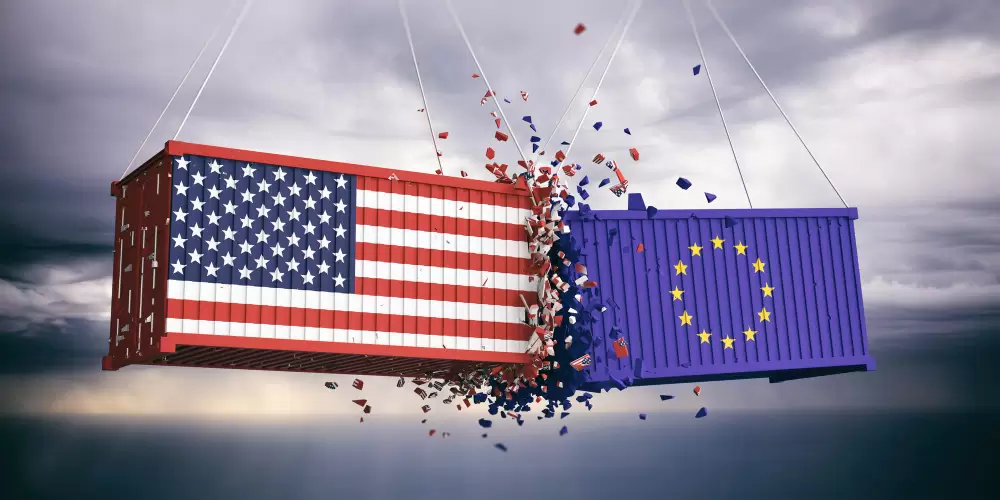- Web Desk
- Nov 20, 2025
Which European firms are most exposed to US market risks?
-

- Web Desk Karachi
- Apr 09, 2025

ITALY: European companies with significant exposure to the US face heightened risks due to tariffs, recession concerns, and a declining dollar, as highlighted by a recent analysis from Goldman Sachs. Following three days of global market declines triggered by new US tariffs, investors are keen to pinpoint vulnerable European firms as well as those that may be more resilient.
The latest wave of volatility was sparked by President Donald Trump’s imposition of hefty tariffs on major trading partners, including a 34 percent tariff on Chinese imports and a 20 percent duty on select European products. This escalation has raised fears of a renewed global trade conflict, significantly impacting equity markets and corporate earnings forecasts.
Goldman Sachs’ report, led by chief equity strategist Peter Oppenheimer, indicates increasing risks for European firms, noting that around 30 percent of their assets are now in the US—up from less than 20 percent in 2013. The analysis reveals that North America has become the largest market for European companies, surpassing that of the UK, Germany, and China combined.
On average, firms in the Euro STOXX 600 index derive 26 percent of their revenues from North America, though this exposure varies by industry.
Which European companies are most vulnerable to US tariffs?
Companies heavily reliant on US sales face a dual threat from tariffs on their products and a diminishing dollar, which diminishes their profits in euros.
Key firms at risk include Dutch supermarket giant Ahold Delhaize, which gets over 60 percent of its revenue from store chains like Stop & Shop; the UK’s Ashtead Group, generating over 70 percent of its income from US subsidiary Sunbelt Rentals; Germany’s Fresenius Medical Care, a major player in American healthcare; and distribution firm Bunzl, with a substantial dependency on North American sales.
Other companies facing notable challenges include catering leader Compass Group, credit agency Experian, educational publisher Pearson, analytics company RELX Plc, hotel group InterContinental Hotels Group, pest control provider Rentokil Initial, and industrial technology firm Smiths Group. Meanwhile, pharmaceutical giants like Denmark’s Novo Nordisk, Switzerland’s Roche, and France’s Sanofi, while having significant US sales, currently remain exempt from tariffs.
Goldman Sachs raises odds of US recession to 45pc, second hike in a week
Goldman Sachs economists now estimate a 45 percent chance of a US recession, a figure that could rise if all proposed trade tariffs are enacted. Companies in the media and healthcare sectors are deemed to have the highest exposure to the US market and may be adversely affected by slower economic growth. Conversely, those in real estate appear to be better positioned, benefiting from limited international exposure.
Domestic-focused European companies are likely to navigate tariff challenges more successfully. While a global downturn could hurt their sales, their reliance on local markets offers a level of protection against the fallout from US exports. These firms often operate in regulated sectors, such as utilities, telecommunications, and domestic finance.
Examples include Spanish utility companies Endesa and Redeia, which primarily operate in Spain; Italian banks Intesa Sanpaolo and Nexi, which rely on local demand; and French real estate firms Covivio and Klepierre, which have stable revenue streams shielded from US tariffs. Similarly, German property groups LEG Immobilien and Vonovia serve primarily local tenants, while firms like Amplifon, CaixaBank, and Cellnex Telecom focus predominantly on domestic markets, reducing their exposure to fluctuations in the US economy.
European investors are also contending with a “triple threat”: increased tariff risks, weakening US economic growth, and declining dollar values. Goldman Sachs notes that European investors currently hold about 50 percent of their equity investments in US markets, a strategy that has historically provided returns during periods of stagnation in Europe. However, the analysts predict the euro could strengthen to 1.20 against the dollar and the British pound to 1.39 over the next year, further decreasing the euro value of profits generated in the US.
Reflecting these challenges, Goldman Sachs has downgraded its earnings forecasts for European firms, predicting a 7 percent decline in earnings per share for 2025 and flat growth for 2026, far below earlier expectations. Oppenheimer cautioned of potential downsides, noting that historical trends show European earnings typically fall by 20 percent during recessions, with cyclical sectors experiencing declines of up to 30% to 40 percent.




